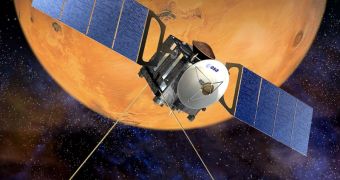Mars Advanced Radar for Substance and Ionospheric Sounding or MARSIS sent back lately some of the most exciting data ever. MARSIS is an experiment aboard the ESA's Mars Express. Originally composed of two parts, the Mars Express Orbiter and the Beagle 2 lander were designed to perform exobiology and geochemistry, only the Mars Express Orbiter is now functional due to the failure of the lander to safely reach the Martian surface.
Though Mars is considered the sister planet of Earth, there are major differences regarding them, such as the upper atmosphere, called the ionosphere. The ionized layer of atmosphere has a crucial role in deflecting the radio wave radiation coming from space, but not much was known about the Mars ionosphere, until the analysis made by MARSIS.
Mars' ionosphere is generally located about 110 to 130 kilometers above the surface of the planet and is caused by radiation from the solar wind, hitting the atoms in the upper atmosphere, determining them to split and emit free electrons. The most surprising discovery was made in a region of the ionosphere, located above the hemisphere of the planet which is in the dark.
The probe which equips the Mars Express was mainly designed to explore the unseen geological structures situated beneath the surface, but can also be used to learn valuable information about the ionosphere. The reason for this is that the radio waves emitted by MARSIS are partially reflected or modified as they pass through the ionised layer of the atmosphere, receiving back the echoes of the original signal.
Data extracted from about 750,000 echoes has been used to construct a map of the distribution of electrons in the ionosphere, also known as the total electron content. The technique used for the probing is called 'transmission mode' and uses a radar to transmit a pulse through the ionosphere twice, once to send the signal to the surface and once to send the signal back to the collector probe, instead of using the technique of reflecting the signal on the ionosphere just once.
As the radar signal travels through the atmosphere, the echoes received are weakened, delayed and dispersed according to the electron density present in the ionosphere. The density of the electrons in the ionosphere seems to be in connection with the direction of the local Martian magnetic field, thus confirming that the density of the electrons is strongly connected to the magnetic field lines, perpendicular to the surface.
The presence of the solar wind around the planet creates high densities of electrons, on the night side of the planet. In the future, as the orbit of the spacecraft falls further into the region of space over the night side of the planet, the MARSIS probe is expected to provide even more detailed maps of the ionosphere, in the regions where the solar wind connects with the magnetic field.

 14 DAY TRIAL //
14 DAY TRIAL //